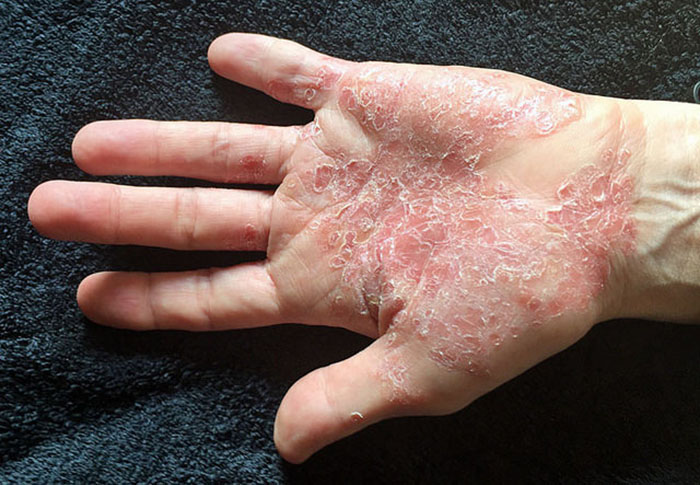Psoriasis is a skin condition that causes skin redness, white patches, and irritation. It’s not contagious and does not have a generalized impact on your overall health. Psoriasis can start at any age but generally occurs among people in their 20s or people over 50. Psoriasis affects the elbows and scalp but can also appear on legs and nails. It may also start off on any part of the body and may appear following a more serious health situation like a heart condition, depression, and diabetes. Most common types of psoriasis are plaque, guttate, inverse, pustular, and erythrodermic.

Photo by Psoriasis-Netz / CC by
Types of Psoriasis
Plaque Psoriasis – This type of psoriasis is the most common as about 80 percent of the population suffers from it, which is why information on plaque psoriasis treatments is often more easily found. It is marked by silver/white patches and inflamed,red lesions on the skin. Affected skin is usually very dry and sensitive so the person affected usually experiences a good amount of discomfort. It’s generally found on the elbows, knees, scalp, and lower back. Where plaque psoriasis treatments are concerned, you will likely be prescribed a topical therapy. However, you also have some over-the-counter psoriasis treatment options like 1% hydrocortisone cream.
Guttate Psoriasis – This type begins in childhood and appears in the form of tiny, individual red spots on the skin, usually on the trunk or limbs. 10% of the population has this type of psoriasis.
Inverse Psoriasis – Inverse psoriasis occurs due to irritation from rubbing and sweat because of it is usually located in the folds of the skin and tender areas. It is extra common and very uncomfortable in overweight people with deep skin folds. It first appears as lesions that are very red and usually lack the scale associated with plaque psoriasis. It may even appear smooth and shiny.
Pustular Psoriasis – Primarily observed in adults, this type of psoriasis generally appears as bumps on the skin. It affects less than 10% of the population – they are particularly common on hands and feet.
Causes of Psoriasis
No one can identify what exactly causes psoriasis. However, it is understood that the immune system and genetics play major roles in its development. Many researchers have found that psoriasis is mainly a disorder of unnecessary growth and reproduction of skin cells. The ailment is simply seen as a mistake of the epidermis and its keratinocytes.
- Throat infections can activate psoriasis.
- Smoking and alcohol are two factors which can trigger psoriasis.
- Stress and trauma may also trigger psoriasis.
There are many psoriasis treatments depending on the harshness of the skin condition. Topical psoriasis treatments are usually the best way to get beautiful, glowing skin and also lessen the effects of psoriasis. Your overall health also makes a huge difference; if your health is not in good condition, then you probably already don’t have healthy skin, so coping with psoriasis might be extra struggling for you.
There is no cure for psoriasis, however, there are remedies you can be prescribed or over-the-counter products you can purchase to lessen your discomfort. Of course, as is the case with every other illness, make sure your psoriasis treatment medications don’t interfere with your prescription medications or any other dietary supplements, like multivitamins, you might be taking daily. It’s always a sound idea to discuss your psoriasis treatment options with your doctor before making a decision.
Featured Image Source: Thinkstock/PositiveFocus
Posted on February 15, 2023


